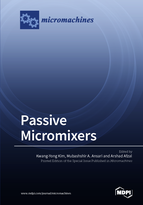Passive Micromixers
A special issue of Micromachines (ISSN 2072-666X).
Deadline for manuscript submissions: closed (31 January 2018) | Viewed by 71471
Special Issue Editors
Interests: micromixer; micro heat sink; fluid machinery; optimization; heat transfer
Special Issues, Collections and Topics in MDPI journals
Interests: MEMS; microfluidics; micromixer; microparticle separation
Special Issue Information
Dear Colleagues,
Micro-total analysis systems and lab-on-a-chip platforms are widely used for sample preparation and analysis, drug delivery, and biological and chemical syntheses. Micromixer is an important component in these applications. Rapid and efficient mixing is a challenging task in the design and development of micromixers. The flow in micromixers is laminar, and, thus, the mixing is primarily dominated by diffusion. Recently, diverse techniques have been developed to promote mixing by enlarging the interfacial area between the fluids or by increasing the residential time of fluids in the micromixer. Based on their mixing mechanism, micromixers are classified into two types: Active and passive. Passive micromixers are easy to fabricate and generally use geometry modification to cause chaotic advection or lamination to promote the mixing of the fluid samples, unlike active micromixers which use moving parts or some external agitation/energy for the mixing. Many researchers have studied various geometries to design efficient passive micromixers. Recently, numerical optimization techniques based on computational fluid dynamic analysis have been proven to be efficient tools in the design of micromixers. The current Special Issue covers new mechanism, design, numerical and/or experimental mixing analysis, and design optimization of various passive micromixers.
Prof. Dr. Kwang-Yong Kim
Prof. Dr. Mubashshir A. Ansari
Dr. Arshad Afzal
Guest Editors
Manuscript Submission Information
Manuscripts should be submitted online at www.mdpi.com by registering and logging in to this website. Once you are registered, click here to go to the submission form. Manuscripts can be submitted until the deadline. All submissions that pass pre-check are peer-reviewed. Accepted papers will be published continuously in the journal (as soon as accepted) and will be listed together on the special issue website. Research articles, review articles as well as short communications are invited. For planned papers, a title and short abstract (about 100 words) can be sent to the Editorial Office for announcement on this website.
Submitted manuscripts should not have been published previously, nor be under consideration for publication elsewhere (except conference proceedings papers). All manuscripts are thoroughly refereed through a single-blind peer-review process. A guide for authors and other relevant information for submission of manuscripts is available on the Instructions for Authors page. Micromachines is an international peer-reviewed open access monthly journal published by MDPI.
Please visit the Instructions for Authors page before submitting a manuscript. The Article Processing Charge (APC) for publication in this open access journal is 2600 CHF (Swiss Francs). Submitted papers should be well formatted and use good English. Authors may use MDPI's English editing service prior to publication or during author revisions.
Keywords
passive micromixer
micromixer design
analysis of mixing
design optimization
mixing mechanism








